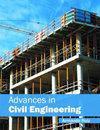Influence of Mechanical and Microscopic Properties of Red Sandstone Modified by Different Solid Waste Materials
IF 1.6
4区 工程技术
Q3 CONSTRUCTION & BUILDING TECHNOLOGY
引用次数: 0
Abstract
To improve the strength of red sandstone roadbed and elevate the utilization rate of solid waste materials, this study explored the enhancement of red sandstone using three types of solid waste materials: slag-micronized powder, fly ash, and waste incineration bottom ash. The mechanical properties of various solid waste materials, including compaction, unconfined compressive strength, and disintegration test results, were evaluated to assess the enhancement of red sandstone. Additionally, scanning electron microscopy was employed to analyze the microstructural alterations induced by these materials. The results indicated that the optimal moisture content of fly ash-improved soil and slag micropowder-improved soil gradually increased, whereas the maximum dry density decreased with an increase in the solid waste material admixture. At an 11% dosage of waste incineration bottom ash, the maximum unconfined compressive strength reached 2,386 kPa. The soil–water characteristic curves for the different solid waste materials exhibited a similar overall trend. Notably, the disintegration rate significantly slowed at a 9% dosage of fly ash, whereas at 11% dosage of waste incineration bottom ash, the disintegration rate nearly reached 0%, demonstrating optimal improvement effects. This suggested that the bottom ash effectively enhanced the water stability performance of red sandstone and increased its resistance to disintegration. Microscopic analysis revealed that slag micropowder and fly ash were comparatively less effective in enhancing red sandstone. The waste incineration bottom ash efficiently generated substantial cementitious material to fill pores. In summary, employing 11% waste incineration bottom ash was recommended to enhance red sandstone in practical roadbed improvement projects.不同固废材料改性红砂岩力学和显微性能的影响
为了提高红砂岩路基的强度,提高固体废弃物材料的利用率,本研究探讨了使用矿渣微粉、粉煤灰和垃圾焚烧底灰三种固体废弃物材料增强红砂岩的效果。研究评估了各种固体废弃物材料的机械性能,包括压实度、无侧限抗压强度和崩解试验结果,以评估红砂岩的增强效果。此外,还采用扫描电子显微镜分析了这些材料引起的微观结构变化。结果表明,粉煤灰改良土壤和矿渣微粉改良土壤的最佳含水量逐渐增加,而最大干密度则随着固体废弃物掺量的增加而降低。当垃圾焚烧底灰掺量为 11% 时,最大无压抗压强度达到 2,386 kPa。不同固废材料的水土特性曲线呈现出相似的总体趋势。值得注意的是,当粉煤灰的用量为 9% 时,崩解速率明显减慢,而当垃圾焚烧底灰的用量为 11% 时,崩解速率几乎达到 0%,显示出最佳的改良效果。这表明,底灰能有效提高红砂岩的水稳定性能,增强其抗崩解能力。显微分析表明,矿渣微粉和粉煤灰对红砂岩的改良效果相对较差。而垃圾焚烧底灰能有效地产生大量胶凝材料来填充孔隙。总之,建议在实际路基改善工程中使用 11% 的垃圾焚烧底灰来增强红砂岩。
本文章由计算机程序翻译,如有差异,请以英文原文为准。
求助全文
约1分钟内获得全文
求助全文
来源期刊

Advances in Civil Engineering
Engineering-Civil and Structural Engineering
CiteScore
4.00
自引率
5.60%
发文量
612
审稿时长
15 weeks
期刊介绍:
Advances in Civil Engineering publishes papers in all areas of civil engineering. The journal welcomes submissions across a range of disciplines, and publishes both theoretical and practical studies. Contributions from academia and from industry are equally encouraged.
Subject areas include (but are by no means limited to):
-Structural mechanics and engineering-
Structural design and construction management-
Structural analysis and computational mechanics-
Construction technology and implementation-
Construction materials design and engineering-
Highway and transport engineering-
Bridge and tunnel engineering-
Municipal and urban engineering-
Coastal, harbour and offshore engineering--
Geotechnical and earthquake engineering
Engineering for water, waste, energy, and environmental applications-
Hydraulic engineering and fluid mechanics-
Surveying, monitoring, and control systems in construction-
Health and safety in a civil engineering setting.
Advances in Civil Engineering also publishes focused review articles that examine the state of the art, identify emerging trends, and suggest future directions for developing fields.
 求助内容:
求助内容: 应助结果提醒方式:
应助结果提醒方式:


